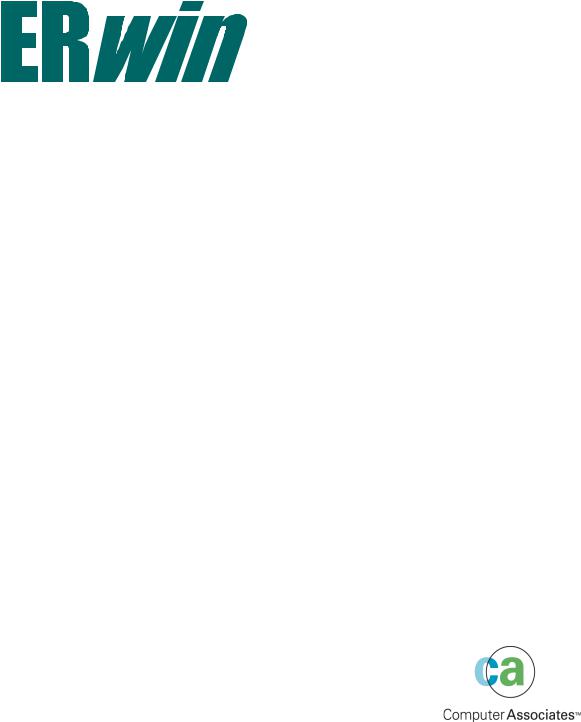
- •Contents
- •Intended Audience
- •Typographical Conventions
- •Benefits of Data Modeling
- •Data Modeling Sessions
- •Session Roles
- •Sample IDEF1X Modeling Methodology
- •Logical Models
- •The Entity Relationship Diagram
- •The Key-Based Model
- •The Fully-Attributed (FA) Model
- •Physical Models
- •The Transformation Model
- •The DBMS Model
- •Benefits of Data Modeling in ERwin
- •The Entity-Relationship Diagram
- •Defining Entities and Attributes
- •Logical Relationships
- •Many-to-Many Relationships
- •Validating the Design of the Logical Model
- •Data Model Example
- •Identifying Types of Keys
- •Selecting a Primary Key
- •Designating Alternate Key Attributes
- •Designating Inversion Entry Attributes
- •Relationships and Foreign Key Attributes
- •Dependent and Independent Entities
- •Identifying Relationships
- •Non-Identifying Relationships
- •Rolenames
- •Naming Entities and Attributes
- •Synonyms, Homonyms, and Aliases
- •Entity Definitions
- •Definition References and Circularity
- •Constructing a Business Glossary
- •Attribute Definitions
- •Rolenames
- •Definitions and Business Rules
- •Relationship Cardinality
- •Cardinality in Non-Identifying Relationships
- •Referential Integrity
- •Reading Referential Integrity Options
- •RI, Cardinality, and Identifying Relationships
- •RI, Cardinality, and Non-Identifying Relationships
- •Additional Relationship Types
- •Many-to-Many Relationships
- •N-ary Relationships
- •Recursive Relationships
- •Subtype Relationships
- •Complete Versus Incomplete Subtype Structures
- •Inclusive and Exclusive Relationships
- •When to Create a Subtype Relationship
- •Overview of the Normal Forms
- •Functional Dependence (FD)
- •Full Functional Dependence
- •First Normal Form (1NF)
- •Second Normal Form (2NF)
- •Third Normal Form (3NF)
- •Common Design Problems
- •Repeating Data Groups
- •Multiple Use of the Same Attribute
- •Multiple Occurrences of the Same Fact
- •Conflicting Facts
- •Derived Attributes
- •Missing Information
- •Unification
- •How Much Normalization Is Enough?
- •ERwin Support for Normalization
- •First Normal Form Support
- •Second and Third Normal Form Support
- •Creating a Physical Model
- •Summary of Logical and Physical Model Components
- •Denormalization
- •Classification of Dependent Entities
- •Glossary
- •Index

®
MethodsGuide
4.0
This documentation and related computer software program (hereinafter referred to as the “Documentation”) is for the end user’s informational purposes only and is subject to change or withdrawal by Computer Associates International, Inc. (“CA”) at any time.
This documentation may not be copied, transferred, reproduced, disclosed or duplicated, in whole or in part, without the prior written consent of CA. This documentation is proprietary information of CA and protected by the copyright laws of the United States and international treaties.
Notwithstanding the foregoing, licensed users may print a reasonable number of copies of this documentation for their own internal use, provided that all CA copyright notices and legends are affixed to each reproduced copy. Only authorized employees, consultants, or agents of the user who are bound by the confidentiality provisions of the license for the software of the user will have access to such copies.
This right to print copies is limited to the period during which the license for the product remains in full force and effect. Should the license terminate for any reason, it shall be the user’s responsibility to return to CA the reproduced copies or to certify to CA that same have been destroyed.
To the extent permitted by applicable law, CA provides this documentation “as is” without warranty of any kind, including without limitation, any implied warranties of merchantability, fitness for a particular purpose or noninfringement. In no event will CA be liable to the end user or any third party for any loss or damage, direct or indirect, from the use of this documentation, including without limitation, lost profits, business interruption, goodwill, or lost data, even if CA is expressly advised of such loss or damage.
The use of any product referenced in this documentation and this documentation is governed by the end user’s applicable license agreement.
The manufacturer of this documentation is Computer Associates International, Inc.
Provided with “Restricted Rights” as set forth in 48 C.F.R. Section 12.212, 48 C.F.R. Sections 52.227-19(c)(1) and (2) or DFARS Section 252.227.7013(c)(1)(ii) or applicable successor provisions.
2001 Computer Associates International, Inc., One Computer Associates Plaza, Islandia, New York 11749. All rights reserved.
All trademarks, trade names, service marks, or logos referenced herein belong to their respective companies.

Contents
Chapter 1: Introduction
Intended Audience............................................................................ |
1–2 |
Typographical Conventions .................................................................... |
1–2 |
Chapter 2: Information Systems, Databases, and Models
Benefits of Data Modeling ..................................................................... |
2–1 |
Data Modeling Sessions ....................................................................... |
2–3 |
Session Roles ............................................................................. |
2–3 |
Sample IDEF1X Modeling Methodology......................................................... |
2–4 |
Logical Models ............................................................................... |
2–6 |
The Entity Relationship Diagram ........................................................... |
2–6 |
The Key-Based Model ..................................................................... |
2–6 |
The Fully-Attributed (FA) Model ........................................................... |
2–6 |
Physical Models .............................................................................. |
2–7 |
The Transformation Model ................................................................. |
2–7 |
The DBMS Model ......................................................................... |
2–7 |
Benefits of Data Modeling in ERwin ............................................................ |
2–8 |
Chapter 3: Constructing a Logical Model
The Entity-Relationship Diagram ............................................................... |
3–2 |
Defining Entities and Attributes ............................................................ |
3–3 |
Logical Relationships ...................................................................... |
3–4 |
Many-to-Many Relationships ............................................................... |
3–5 |
Validating the Design of the Logical Model ...................................................... |
3–6 |
Data Model Example .......................................................................... |
3–7 |
Contents iii

Chapter 4: Designing a Key-Based Data Model
Identifying Types of Keys ..................................................................... |
4–2 |
Selecting a Primary Key ................................................................... |
4–2 |
Designating Alternate Key Attributes ....................................................... |
4–4 |
Designating Inversion Entry Attributes ..................................................... |
4–4 |
Relationships and Foreign Key Attributes ....................................................... |
4–5 |
Dependent and Independent Entities ....................................................... |
4–5 |
Identifying Relationships .................................................................. |
4–7 |
Non-Identifying Relationships ............................................................. |
4–7 |
Rolenames ............................................................................... |
4–9 |
Chapter 5: Naming and Defining Entities and Attributes
Naming Entities and Attributes ................................................................ |
5–1 |
Synonyms, Homonyms, and Aliases ........................................................ |
5–2 |
Entity Definitions............................................................................. |
5–3 |
Definition References and Circularity ....................................................... |
5–4 |
Constructing a Business Glossary........................................................... |
5–5 |
Attribute Definitions .......................................................................... |
5–6 |
Rolenames ................................................................................... |
5–7 |
Definitions and Business Rules................................................................. |
5–9 |
Chapter 6: Refining Model Relationships
Relationship Cardinality ...................................................................... |
6–2 |
Cardinality in Non-Identifying Relationships ................................................ |
6–4 |
Referential Integrity .......................................................................... |
6–5 |
Reading Referential Integrity Options....................................................... |
6–7 |
RI, Cardinality, and Identifying Relationships ............................................... |
6–8 |
RI, Cardinality, and Non-Identifying Relationships........................................... |
6–9 |
Additional Relationship Types ................................................................ |
6–10 |
Many-to-Many Relationships ................................................................. |
6–11 |
N-ary Relationships.......................................................................... |
6–13 |
Recursive Relationships ...................................................................... |
6–15 |
Subtype Relationships ....................................................................... |
6–17 |
Complete Versus Incomplete Subtype Structures............................................ |
6–20 |
Inclusive and Exclusive Relationships...................................................... |
6–21 |
When to Create a Subtype Relationship .................................................... |
6–22 |
iv ERwin Methods Guide

Chapter 7: Normalization
Overview of the Normal Forms................................................................. |
7–2 |
Functional Dependence (FD) ............................................................... |
7–2 |
Full Functional Dependence ................................................................ |
7–2 |
First Normal Form (1NF)................................................................... |
7–2 |
Second Normal Form (2NF) ................................................................ |
7–2 |
Third Normal Form (3NF).................................................................. |
7–2 |
Common Design Problems..................................................................... |
7–3 |
Repeating Data Groups .................................................................... |
7–3 |
Multiple Use of the Same Attribute ......................................................... |
7–5 |
Multiple Occurrences of the Same Fact ...................................................... |
7–8 |
Conflicting Facts .......................................................................... |
7–9 |
Derived Attributes ....................................................................... |
7–12 |
Missing Information ...................................................................... |
7–13 |
Unification .................................................................................. |
7–14 |
How Much Normalization Is Enough? ......................................................... |
7–16 |
ERwin Support for Normalization ............................................................. |
7–18 |
First Normal Form Support ............................................................... |
7–18 |
Second and Third Normal Form Support ................................................... |
7–19 |
Chapter 8: Creating a Physical Model
Creating a Physical Model ..................................................................... |
8–2 |
Summary of Logical and Physical Model Components ........................................ |
8–2 |
Denormalization .............................................................................. |
8–3 |
Appendix A: Dependent Entity Types
Classification of Dependent Entities............................................................ A–1
Glossary
Index
Contents v

Chapter
1 Introduction
Welcome to data modeling with ERwin. If you have never seen a model before, the ERwin Methods Guide will help you understand what a model is, and what it is good for. If you already have some experience with data and data models, you know how useful they can be in understanding the requirements of your business. A model can help you design new information systems or maintain and modify existing ones.
Data modeling is not something that can be covered in a lot of detail in a short document like this one. But by the time you have read it, you will understand enough, even if you are just a beginner, to put ERwin’s methods to work for you. Overall, the ERwin Methods Guide has the following purposes:
■To provide a basic level of understanding of the data modeling method used by ERwin that is sufficient to do real database design.
■To introduce some of the descriptive power and richness of the IDEF1X and IE modeling languages supported by ERwin and to provide a foundation for future learning.
■To provide additional information so you can better understand ERwin’s modeling features.
This document covers the methods of data modeling supported by ERwin, which include:
■IDEF1X. The IDEF1X method was developed by the U.S. Air Force. It is now used in various governmental agencies, in the aerospace and financial industry, and in a wide variety of major corporations.
■IE (Information Engineering). The IE method was developed by James Martin, Clive Finkelstein, and other IE authorities and is widely deployed in a variety of industries.
Both methods are suited to environments where large scale, rigorous, enterprisewide data modeling is essential.
Introduction 1–1
